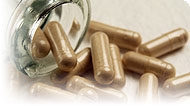Vitamin C for Sports & Fitness

How Much Is Usually Taken by Athletes?
Placebo-controlled research, some of it double-blind, has shown that taking 400 to 3,000 mg of vitamin C per day for several days before and after intense exercise may reduce pain and speed up muscle strength recovery.1, 2, 3 However, taking vitamin C only after such exercise was not effective in another double-blind study.4
In most well-controlled studies, exercise performance has not been shown to improve following supplementation with vitamin C, unless a deficiency exists, as might occur in athletes with unhealthy or irrational eating patterns.5, 6 Similarly, vitamin E has not benefited exercise performance, 7, 8 except possibly at high altitudes.9, 10
Side Effects
Caution: People with the following conditions should consult their doctor before supplementing with vitamin C: glucose-6-phosphate dehydrogenase deficiency, iron overload (hemosiderosis or hemochromatosis), history of kidney stones, or kidney failure.
Some people develop diarrhea after as little as a few grams of vitamin C per day, while others are not bothered by ten times this amount. Strong scientific evidence to define and defend an upper tolerable limit for vitamin C is not available. A review of the available research concluded that high intakes (2–4 grams per day) are well-tolerated by healthy people.11
It is widely (and mistakenly) believed that mothers who consume large amounts of vitamin C during pregnancy are at risk of giving birth to an infant with a higher-than-normal requirement for the vitamin. The concern is that the infant could suffer “rebound scurvy,” a vitamin C deficiency caused by not having this increased need met. Even some medical textbooks have subscribed to this theory.12 In fact, however, the concept of “rebound scurvy” in infants is supported by extremely weak evidence.13 Since the publication in 1965 of the report upon which this mistaken notion is based, millions of women have consumed high amounts of vitamin C during pregnancy and not a single new case of rebound scurvy has been reported.14
A preliminary study found that people who took 500 mg per day of vitamin C supplements for one year had a greater increase in wall thickness of the carotid arteries (vessels in the neck that supply blood to the brain) than those who did not take vitamin C.15 Thickness of carotid artery walls is an indicator of progression of atherosclerosis. Currently, no evidence supports a cause-and-effect relationship for the outcome reported in this study. The vast preponderance of research suggests either a protective or therapeutic effect of vitamin C for heart disease, or no effect at all.
It has been suggested that people who form calcium oxalate kidney stones should avoid vitamin C supplements, because vitamin C can be converted into oxalate and increase urinary oxalate.16, 17 Initially, these concerns were questioned because of potential errors in the laboratory measurement of oxalate.18, 19 However, using newer methodology that rules out this problem, recent evidence shows that as little as 1 gram of vitamin C per day can increase the urinary oxalate levels in some people, even those without a history of kidney stones.20, 21 In one case, 8 grams per day of vitamin C led to dramatic increases in urinary oxalate excretion and kidney stone crystal formation causing bloody urine.22 People with a history of kidney stones should consult a doctor before taking large amounts (1 gram or more per day) of supplemental vitamin C.
Despite possible therapeutic effects of vitamin C in people with diabetes at lower intakes, one case of increased blood sugar levels was reported after taking 4.5 grams per day.23
Interactions with Supplements, Foods, & Other Compounds
Intake of large amounts of vitamin C can deplete the body of copper24, 25—an essential nutrient. People should be sure to maintain adequate copper intake at higher intakes of vitamin C. Copper is found in many multivitamin-mineral supplements. Vitamin C increases the absorption of iron and should be avoided by people with iron overload diseases (e.g., hemochromatosis, hemosiderosis). Vitamin C helps recycle the antioxidant, vitamin E.
Interactions with Medicines
Certain medicines interact with this supplement.
none | |
none | |
Copyright © 2025 TraceGains, Inc. All rights reserved.
Learn more about TraceGains, the company.
The information presented by TraceGains is for informational purposes only. It is based on scientific studies (human, animal, or in vitro), clinical experience, or traditional usage as cited in each article. The results reported may not necessarily occur in all individuals. Self-treatment is not recommended for life-threatening conditions that require medical treatment under a doctor's care. For many of the conditions discussed, treatment with prescription or over the counter medication is also available. Consult your doctor, practitioner, and/or pharmacist for any health problem and before using any supplements or before making any changes in prescribed medications. Information expires December 2025.
